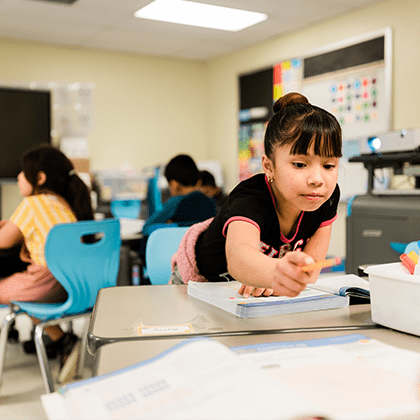Sometimes a student comes into your classroom thinking they are a C student. They get a C, and they are happy. I'm not. I bet you're not either. Our job is never to help students reach their potential but to help students exceed what they believe is their potential. We need to stretch, accelerate, and embrace improvement. We want students to become their own teachers—to know what to do when they don't know what to do.
How Students Learn
We have all met those students who are terrified of getting something wrong. Indeed, the whole point of their being in the classroom is to learn what they don't know. We tend to give them questions we know they can get right and feel good about, but our aim should be not too hard, not too easy, not too boring.
We have also all met those students and adults who think they are poor learners. Often this is because they have limited learning strategies (i.e., when they fail, they apply the same strategy for the same result), have low expectations, or do not have great teachers who have appropriately challenged them to aspire higher.
When you ask your students what it means to be a good learner, they might say, "Someone who knows lots." As far as they're concerned, we're training them for Jeopardy!®. Surely, that's not our purpose as educators. Often, high-achieving students want you to talk more about the facts because that's the game they're winning. Surely, we want more than the facts. If they are receiving 100 percent all the time, surely, the work must be too easy. Those who aim to know lots, only focus on the facts, and are never wrong are most likely to fade out of schooling and learning. Great learners build deeper conceptual understanding, learn patterns across facts, are curious problem solvers, and can transfer what they know and understand to new situations.
We need to ensure that disruptive students refocus on the challenge of learning, the withdrawers and avoiders are enticed into the excitement of learning, the completers of work regardless of quality reignite their passion to explore the challenges and unknowns of learning, and the engagers and investors in knowledge move into the driving seat of learning. Regardless of prior achievements, every student needs exposure to both the facts and rich cognitive relationships between ideas to enjoy, advance, and experience the thrills and joy of learning.
Moving from Achievement to Growth
I have six grandkids in their early years, and I'm struggling to watch them go from four-year-olds full of "why questions" to age 7, when they switch to "what answers." I struggle to watch them enter this compliance phase where it's all about getting the right answer, “doing” the work, and watching the teacher work. I want them to know that learning is about going to the edge and occasionally falling over. It’s about stretching beyond where they are now, making errors and seeking and hearing feedback, and not just getting to the next level (and handing in the work) but looking beyond and enjoying the game of learning.
There's so much focus on high achievement and standards in schools that too many feel they may never be great learners. Sadly, by age 8, many students realize they will not be among the high achievers. So, we need to refocus to emphasize both the value of growth and achievement. It is by growing that students make gains in achievement. When we have high expectations (for both teacher and student), we can accelerate and speed up learning. Students are successful when they know how to learn alone and with others, seek and action feedback, are in high-trust classrooms where not knowing and making errors are welcomed and not seen as embarrassing, and have passionate and great teachers who care about their progress, share their passion for learning, provide appropriately challenging and engaging lessons, and communicate that they see and expect more from each student.
Students are improvement engines. If they do not get sustenance from the classroom, they can refocus on their video games, phones, or social life. These latter know how to challenge and stretch students, sometimes in directions that are not productive and worthwhile. We need to turn their motivations onto our challenging and non-boring foci, provide them with feedback and direction about growth, success, and appropriately challenging tasks, and share our high expectations, confidence, and skills to lead to mastery and the joys of learning.
This all requires stretching, accelerating, challenging, improving, spreading self-belief, and infecting the school day with the virus of joyful learning.
Want more from Hattie? Tune into his Ferguson Institute presentation.
Jeopardy!® is a registered trademark of Jeopardy Productions, Inc.








